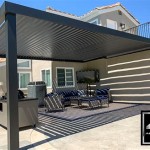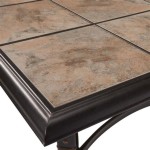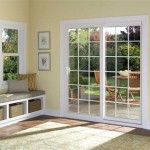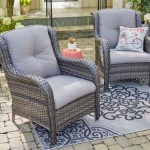Furniture Solutions for Small Patio Spaces
Outdoor living spaces offer a valuable extension of the home, providing areas for relaxation, entertainment, and connection with nature. However, maximizing the potential of a small patio requires careful consideration of furniture choices. The goal is to create a functional and inviting environment without overwhelming the limited square footage. Strategic selection of furniture pieces that prioritize space-saving designs, versatility, and durability is paramount.
The initial step in furnishing a small patio involves assessing the available space and identifying the primary intended purpose of the area. Is the patio primarily for dining, lounging, or a combination of both? Understanding the intended use will guide the selection of appropriate furniture and ensure that the space is optimized for its designated function. Careful measurement of the patio dimensions is crucial to avoid purchasing furniture that is too large or impedes movement.
Efficiently utilizing vertical space is another key strategy for maximizing a small patio. This can be achieved through the incorporation of vertical planters, wall-mounted organizers, and multi-tiered furniture. By drawing the eye upward, these elements create a sense of spaciousness and prevent the area from feeling claustrophobic. Prioritizing furniture with a smaller footprint and opting for pieces with dual functionality are also important considerations.
Folding and Stackable Furniture
One of the most effective solutions for small patios is the use of folding and stackable furniture. This type of furniture offers flexibility and allows for easy storage when not in use, freeing up valuable space. Folding chairs and tables can be quickly deployed for impromptu gatherings and then neatly stored away when the occasion is over. Stackable chairs are also advantageous as they can be neatly stacked on top of each other, minimizing their footprint when not in service.
The materials used in folding and stackable furniture should be durable and weather-resistant. Options such as aluminum, powder-coated steel, and teak are often preferred due to their ability to withstand the elements and resist rust, corrosion, and fading. Additionally, selecting furniture with lightweight designs will facilitate easy movement and storage.
When choosing folding or stackable furniture, consider the style and aesthetic of the patio. Options are available in a wide range of designs, from modern and minimalist to traditional and rustic. Selecting furniture that complements the overall design scheme of the patio will create a cohesive and visually appealing space.
Beyond chairs and tables, consider other foldable or stackable elements. For example, a foldable side table can provide a convenient surface for drinks or snacks and then be folded away when not needed. Similarly, stackable planters can create a dynamic vertical garden without taking up excessive floor space.
Multifunctional Furniture
Multifunctional furniture is designed to serve multiple purposes, making it an ideal choice for small patios where space is at a premium. These pieces often incorporate storage compartments, convertible designs, or modular configurations, allowing users to adapt the furniture to their specific needs and maximize the utility of the available space.
A popular example of multifunctional furniture is a storage bench. These benches provide seating while also offering hidden storage space for cushions, blankets, gardening tools, or other outdoor essentials. This helps to keep the patio clutter-free and organized, creating a more relaxing and inviting environment.
Another type of multifunctional furniture is a convertible coffee table. These tables can be adjusted in height to serve as both a coffee table and a dining table, providing flexibility for different activities. Some models also feature hidden storage compartments for magazines, remote controls, or other small items.
Modular furniture also offers a high degree of flexibility and adaptability. Modular seating arrangements can be configured in various ways to suit different needs and preferences. Individual sections can be used as standalone chairs or combined to create a larger sofa or sectional. This allows users to customize the layout of their patio based on the occasion and the number of guests.
When selecting multifunctional furniture, it's important to consider the quality of construction and the durability of the materials. Opt for pieces that are made from weather-resistant materials and designed to withstand the rigors of outdoor use. Pay attention to the hinges, latches, and other moving parts to ensure that they are robust and will not break easily.
Optimizing Space with Smart Design Choices
Beyond the selection of specific furniture pieces, there are several design choices that can contribute to maximizing space in a small patio. These include the use of light and airy colors, the incorporation of mirrors to create the illusion of space, and the strategic placement of plants to add visual interest and create a sense of depth.
Light and airy colors, such as white, cream, and pastel shades, can make a small patio feel more spacious and open. These colors reflect light and create a brighter and more inviting atmosphere. Avoid using dark or heavy colors, as they can make the space feel smaller and more enclosed.
Mirrors are another effective tool for creating the illusion of space. A strategically placed mirror can reflect the surrounding greenery and create a sense of depth, making the patio feel larger than it actually is. Consider hanging a mirror on a wall or incorporating it into a garden structure.
The strategic placement of plants can also enhance the feeling of spaciousness in a small patio. Vertical planters, hanging baskets, and climbing vines can add visual interest and create a sense of depth without taking up valuable floor space. Choose plants that are well-suited to the climate and growing conditions of the patio.
Furthermore, consider incorporating outdoor rugs to define different zones within the patio. An outdoor rug can delineate a seating area from a dining area, creating a more organized and functional space. Choose a rug that is made from weather-resistant materials and is easy to clean.
Lastly, pay attention to the lighting. String lights, lanterns, and candles can create a warm and inviting atmosphere and extend the use of the patio into the evening hours. Consider using solar-powered lights to reduce energy consumption and eliminate the need for electrical outlets.
By carefully considering furniture choices, design strategies, and spatial arrangements, it is possible to transform a small patio into a functional, stylish, and inviting outdoor living space. The key is to prioritize space-saving designs, multifunctional pieces, and clever design elements that maximize the utility of the available square footage.

Patio Furniture For Small Spaces 8 Simple Tips To Try Stauffers

How To Choose Patio Furniture For Small Spaces Bassemiers

40 Small Patio Ideas To Create A Cozy Outdoor Space

All Small Space Patio Furniture Pottery Barn

Small Outdoor Space 3 Tips On How To Fit Your Patio Furniture Today S

Small Space Friendly Outdoor Furniture Jojotastic

The Best Small Space Furniture To Deck Out Your Patio

Outdoor Furniture For Small Spaces Ashley

40 Small Patio Ideas To Create A Cozy Outdoor Space

Small Space Outdoor Furniture For Decks Patios Crate Barrel








